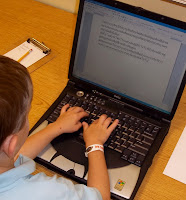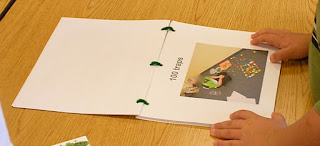Today I am hosting the book study blog party, focusing on chapter 6. Maybe I'm just a slow learner...or slow thinker. But as I read this chapter, a thought hit me about this entire book. Throughout the book I think Brian Puerling is showing ways to use technology to do things that we already do. I know, big revelation. But I think I almost saw a lightning bolt when I thought of this.
In this chapter, Puerling focuses on ways teachers can provide experiences in which children use publication and presentation tools to create:
- Classroom newsletters
- Invitations to class and other events
- Informational articles
- Nonfiction books
- Books inspired by authors
- Video books
I've created newsletters and invitations for the classroom. But I haven't involved the children in doing so. It would be easy to incorporate technology in these experiences. Puerling talks a lot about using teams of kids to tackle different jobs - gathering information, develop content, upload and assemble newsletters, review content and finalize newsletter, make copies or publish electronically. I could see how these steps could be a long-term project for older preschoolers and younger elementary kids. And word processing software could be fairly easy for kids to use.
Puerling also talks about using online services to create and publish books—nonfiction books, original books, and books based on favorite books. These books (from places like Shutterfly) are bound like regular books.
We've published our own books, too. But I've used PowerPoint software, inserting photos and asking kids to provide captions. Then I print them out and bind with binder rings, brads, or chenille stems. More low tech, but cheaper and quicker. However, I may upload some of our books to create a more "real" book from the online services.
Puerling's summary provides some great food for thought: "Too often the learning that happens in a classroom stays in the classroom. Particularly in early childhood classrooms, too often investigations, new ideas, questions, process, and conclusions are not shared with families, school, and community." The strategies in this chapter provide some appropriate ways to develop resources and share learning with families.
Once again, this book has challenged my thinking and helped me consider ways that technology could be integrated in the classroom as another tool for learning.
Check out Preschool Spot for past chapters.
Check out Preschool Spot for past chapters.



